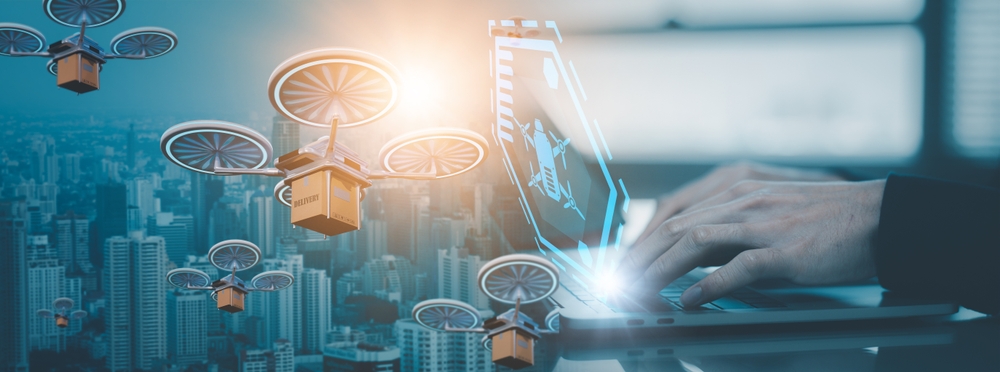
(ART STOCK CREATIVE/Shutterstock)
Drones powered by artificial intelligence have quickly become critical problem-solvers across sectors like agriculture, construction, home delivery, and emergency response. The latest unmanned aerial vehicles (UAVs) are more than just flying cameras; they are mobile AI platforms capable of surveying disaster zones, monitoring crop health, and delivering urgent supplies.
The true value of today’s more advanced drones isn’t just in how fast they fly or how far they travel; it’s in their ability to make intelligent decisions on the fly, and that’s where AI plays a crucial role. Without AI, drones lack the situational awareness needed to respond to dynamic environments in real time.
As drone use cases expand to include longer, higher, and more complex flights, their onboard control systems often struggle to adapt to flight disturbances, such as strong gusts of wind, shifting payloads, or turbulent terrain. Without the ability to adapt in real time, even a well-planned mission can quickly veer off course.
To help drones think more like pilots and less like pre-programmed machines, researchers at MIT have built a new kind of flight control system: one that learns, adapts, and reacts in real time. Instead of relying on preset rules or models built in advance, the system uses AI to detect changes in the environment and then responds instantly. According to the researchers, only 15 minutes of flight time is needed to collect enough real-time observational data to begin making informed adjustments that help counter disturbances during flight. It can determine much thrust each rotor should apply, how the drone tilts, and other types of adjustments.

(greenbutterfly/ShutterStock)
The techniques employed by the researchers automatically determine which optimization algorithm is best suited to overcome the disturbances. The control system is trained using a method called “meta-learning”, which teaches it to adapt to different types of disturbances.
Whether the drone is deployed to monitor fire-prone areas or deliver heavy parcels to residential neighborhoods, this new adaptive control system could significantly improve performance. In simulations, it reduced trajectory tracking errors by 50% compared to standard methods and continued to perform well even with wind speeds it had not encountered during training.
“The concurrent learning of these components is what gives our method its strength. By leveraging meta-learning, our controller can automatically make choices that will be best for quick adaptation,” says Navid Azizan, who is the Esther and Harold E. Edgerton Assistant Professor in the MIT Department of Mechanical Engineering and the Institute for Data, Systems, and Society (IDSS). He is also the principal investigator of the Laboratory for Information and Decision Systems (LIDS), and the senior author of a paper on this control system.
The researchers emphasize that the real challenge in flight control for drones is picking the right algorithm for the situation. In most traditional systems, engineers try to model the drone’s environment in advance, building in assumptions about what kinds of disturbances it might face. But the real world is rarely that predictable.
Instead of guessing, the MIT team let the system figure it out on its own. By swapping out fixed models for a neural network that learns from flight data, and using a technique called mirror descent, the system can try out a range of optimization approaches and choose the one that works best in the moment.

(Shutterstock AI Image)
“Mirror descent is a general family of algorithms, and for any given problem, one of these algorithms can be more suitable than others. The name of the game is how to choose the particular algorithm that is right for your problem. In our method, we automate this choice,” Azizan says.
The current system shows a lot of promise, but for now, it’s designed to adapt to one type of disturbance at a time. The MIT team is working to expand its capabilities so it can respond to multiple challenges at once. For example, fluctuating wind speeds might cause a parcel’s weight to shift mid-flight, especially if the drone is carrying something like a liquid payload. They are also exploring options for continual learning for the system. This would allow the drone to keep adapting to new conditions over time without having to relearn everything from scratch.
MIT’s adaptive control system is just one part of a larger wave of innovation aimed at making drones more intelligent and capable in unpredictable environments. In the firefighting space, Seattle-based startup Data Blanket is using AI to help drones autonomously map wildfire perimeters and track fire behavior in real time. Meanwhile, Auterion offers an open-source drone operating system that enables features like object detection, automated flight paths, and real-time data processing across both commercial and defense sectors.
Projects like TornadoDrone and Lander AI are using real-world flight data to train drones to handle complex aerodynamic challenges. These systems learn to deal with shifting winds, unstable surfaces, and sudden movements with much greater accuracy.
Researchers have also made progress in multi-drone coordination through systems like the DRAL framework, which allows the drones to learn and adapt as a team. This could be useful for carrying heavy items, searching large areas quickly, or inspecting infrastructure. In indoor spaces, coordinated drones can navigate safely without crashing into each other.

